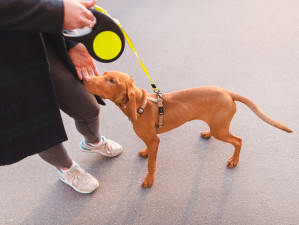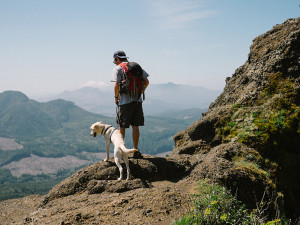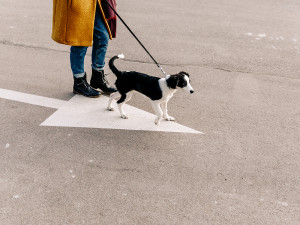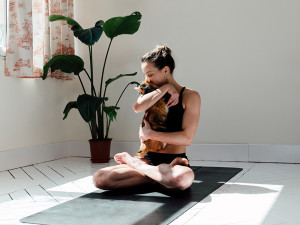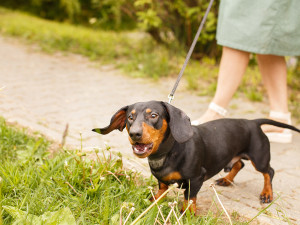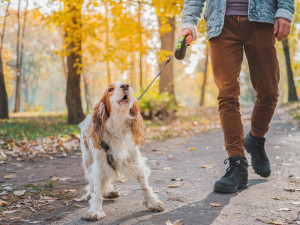Dog Walking 101: How Often You Should Walk Your Dog
Your dog may need more exercise than you think, according to two vets and a behaviorist.

share article

Your pet wants you to read our newsletter. (Then give them a treat.)
When a vet or trainer is trying to diagnose the reason for a dog’s bad behavior, it often boils down to one question: “How often do you walk your dog?” Exercise can make all the difference in a dog’s mental state and behavior. Their needs are not so different from the mental and physical health needs of humans in that way — and they can feel equally tricky to fulfill. (Did I get my steps in the week that Wednesday came to Netflix? I did not.) We all know that exercise is important for our pets, but why is dog walkingopens in a new tab so important? And how often should you walk your dog? A few experts broke it down for us.
How Often You Should Walk Your Dog
First, let’s be clear: There’s a difference between letting your dog out to pee and going for a walk. When it comes to pee breaks, “adult dogs need to be let out for bathroom breaks a minimum of three times a day,” says Dr. Ashley Rossman, a veterinarian at Glen Oak Dog and Cat Hospitalopens in a new tab. “Puppies need even more than that, especially when they’re not yet housebrokenopens in a new tab.” Beyond that, how much time your dog needs to burn off energy will depend on their age and breed.
Factors to Consider
It can feel tricky to figure out exactly how much to walk a dog, since there are no hard-and-fast rules. You’ll have to consider a few different factors, including age and breed. “Younger dogs have more energy than older dogs, obviously, and will need more time to walk or run around,” Dr. Rossman says. “Older dogs, especially ones dealing with issues like arthritis, may need shorter walks to avoid causing additional pain. Working dogs — think Retrievers and Sheepdogs — need at least 30 minutes of significant exercise.” (Those of you with working-group puppies: hope you’ve got good running shoes.) In general, larger dogs are recommended to get more exercise than smaller dogsopens in a new tab.
How often you walk your dog will also depend on whether you have a yard, per Lauren Novack, a certified dog behavior consultant at Behavior Vetsopens in a new tab in NYC. If a dog has free run of the yard, they’re not going to need as formal an exercise routine as a pet whose idea of open space is the hallway from the bedroom to the front door. Still, Novack says people tend to under-exercise their dogs — especially small ones.
On top of age and breed, there’s another factor that can affect the length and quality of your dog’s walk: heatopens in a new tab. “Walks in the summer are tricky,” Dr. Rossman admits. While you can bundle a dog up in the winter, there’s less you can do to manage the temperature on a warm day. So if it’s hot and sunny (temps above 80 degrees Farhrenheit), don’t keep your dog out for too long.” During the summer, early morning or evening walks are your safest options to keep your pet from burning their paw pads or overheating.
“Heat exhaustionopens in a new tab is very real, and the emergency rooms see many cases,” Dr. Rossman adds. Some breeds are more prone to overheating, like Malamutes or Huskies, because they’re bred for colder weather. Older dogs and sick pets can struggle in the heat, too, as can brachycephalic breedsopens in a new tab, such as Pugs, Bulldogs, and Boxers.
“Always remember to bring drinking water for your pet,” she says. “And don’t go hiking midday — if you do, make sure you’re seeking out trails that have plenty of shade so your dog has a way to stay cool.” But a hot day isn’t an excuse to veg out: Keep your dog moving indoors with an old-school tug-of-war session or interactive dog puzzle toysopens in a new tab.
How long should a dog walk be?
“An hour-long walk every day is generally a good recommendation — preferably all in one session,” Novack says. “A long walk benefits a dog’s physical body as well as their mental health. The problem with a 15-minute walk is that you’re not going anywhere new.” If you can’t time block your calendar for an hour-long walk a day, consider hiring a dog walkeropens in a new tab to ensure your dog gets the exercise they need — even if you’re working from home.
What are the benefits of dog walking?
Studies findopens in a new tab that most dogs aren’t getting the recommended amount of exercise, which is a big problem. Walking a dog is a great source of exercise and can have enormous impacts on a dog’s quality of life — and their pet parent’s. Below are a few of the benefits of walking a dog.
Physical Health
Dog walking is great for the physical health of both you and your pupopens in a new tab. Regular walking is associated with a lower risk of cardiovascular disease in humansopens in a new tab, and lack of exercise is associated with obesity in dogsopens in a new tab, which can lead to a handful of health concerns.
Mental Health
Dogs thrive on variety just like we do, so if they’re stuck in the same loop, they’ll eventually find it uninspiring. And dogs who aren’t getting enough exercise become something worse than couch potatoes.
“If you’re not walking your dog enough or providing them with enough playtime, they can become anxiousopens in a new tab or destructiveopens in a new tab,” says Dr. Sara Ochoa, a veterinarian at Whitehouse Veterinary Hospitalopens in a new tab. “They might tear up the house or start licking their paws obsessively.” That energy has to go somewhere, and sometimes it’s going to go into chewing all the wires behind the TV.
Socialization
Socialization is incredibly important for dogs — especially puppies — and dog walking is a great opportunity to introduce your pup to the dogs and people of the world. For puppies, going for walks can help them learn how to interact with other dogs and peopleopens in a new tab and read dog body languageopens in a new tab, plus prevent them from developing phobiasopens in a new tab.
Walking a dog is a great opportunity for humans to socialize, too; many people see a dog as a conversational “icebreaker”opens in a new tab when meeting people in public. Given that loneliness has been declared a public health crisisopens in a new tab by the US Surgeon General, meeting new human friends at the dog park is a welcome side-effect of some puppy bonding time.
Bonding
Walking with your dog gives the two of you plenty of quality time together, and this helps you strengthen your bondopens in a new tab. When the time you spend together is fun, it sends a message to your pup that they can trust you. Animal behaviorist Dr. Karen B. London recommends taking your dog on a “sniffariopens in a new tab” to take the fun up a notch.
Physical Activity Should Be Fun
That said, not all dogs like walking. It makes sense — you may prefer a bike over a treadmill, right? Novack suggests finding a form of activity that excites your dog, like playing fetch or swimmingopens in a new tab. Your dog may even master an agility courseopens in a new tab. Researching what your dog’s breed traditionally enjoys can help, too.
Or maybe it’s you who doesn’t like walks because your dog pulls on their leashopens in a new tab or is aggressive toward other animals. “In that case, try training techniquesopens in a new tab and walking gearopens in a new tab to help your dog heelopens in a new tab, or walk them when you’re less likely to see other dogs, like late at night,” Dr. Ochoa says. (Peak dog-walking hours tend to be right after rush hour, when people get home from work.)
Frequently Asked Questions
Is there a recommended daily walk duration for dogs?
According to certified dog trainer Lauren Novack, an hour-long walk every day is generally a good recommendation. Specific needs depend on the breed and age of your dog.
How many days a week should I walk my dog; do dogs need to be walked every day?
Ideally, you should walk your dog every day.
What is the best time to walk your dog?
There’s not one ideal walking schedule for dogs; the best time to walk your dog is whenever fits in best with your and your pup’s day. In hot weather, you may want to walk your dog in the early morning or late evening, when the temperature is lower and the ground is not too hot.
Should I feed my dog before or after a walk?
You can feed a dog before or after exercise, but it’s important to wait about an hour before or after the walkopens in a new tab. Feeding too soon before or after physical activity can be bad for your pup’s digestion — and it can even be dangerous, since eating soon after exercise may cause them to inhale more air when eating, which can lead to bloatopens in a new tab.
What is the safest way to walk a dog?
There are several factors to consider to keep your walk safe. It’s important for you, your pup’s, and your community’s safety that your dog is leash trainedopens in a new tab. Always use proper exercise equipmentopens in a new tab. Keep your pup hydrated and safe from any harsh weatheropens in a new tab.
What is the purpose of walking a dog?
Walking a dog is important for your dog’s emotional and physical health. It also promotes bonding and provides an opportunity for you and your dog to socialize.
Citations

Colleen Stinchcombe
Colleen Stinchcombe lives near Seattle, WA, where she works as a writer, editor, and content strategist. Her two rescue pups wish she were a professional ball-thrower.
Related articles
![girl with blue hair starting puppy training with white dog]() opens in a new tab
opens in a new tabPuppy Training 101: How to Train a Puppy
You gotta start somewhere.
![French bulldog smiling with blue harness]() opens in a new tab
opens in a new tabStrap in: Dog Collars vs. Harnesses
Style and safety don’t have to be mutually exclusive (phew).
![A shy looking dog sitting on a couch.]() opens in a new tab
opens in a new tabSome Dogs Are Scaredy Cats — And That’s OK
Not all fearful dogs have been mistreated.
![A woman walking a dog on a leash and a dog barking at something.]() opens in a new tab
opens in a new tabIs Your Out-of-Control Dog Lunging on the Leash?
Even a mild-mannered dog can turn into a wild thing when feeling trapped.
![Barking dog on the leash outdoors. Russian spaniel at a walk misbehaving or being bad tempered]() opens in a new tab
opens in a new tabDoes Your Dog Act Diabolical on a Leash?
Same! Here’s how I got my pup to stop barking and lunging at everything that moves on walks.
- opens in a new tab
“How Can I Curb My Dog’s Squirrel Obsession?”
Dog trainer Robert Haussmann’s pro tips for walking a pup that wants to chase everything that moves.
